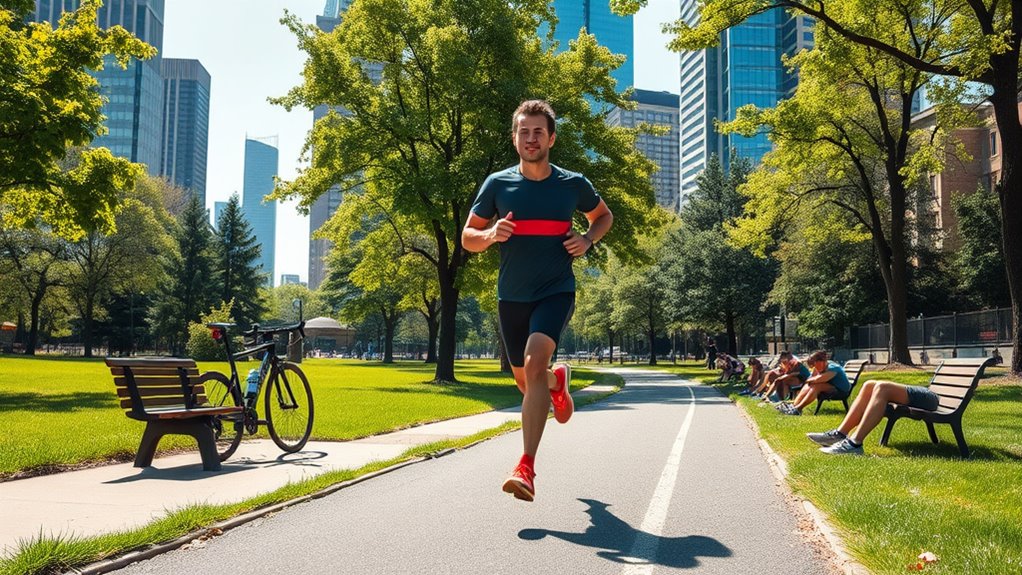To fit a quick 30-minute lunch-break workout into your busy schedule, start with dynamic stretches to warm up and loosen muscles. Incorporate high-intensity circuits like jumping jacks, push-ups, and squats, or opt for brisk walking with core exercises. Be sure to stay hydrated and finish with static stretches to cool down and prevent soreness. With some planning, you can boost energy and stay on track—stay tuned to discover even more effective tips to maximize your lunch break workouts.
Key Takeaways
- Incorporate quick bodyweight exercises like jumping jacks, push-ups, and squats for an efficient workout.
- Use high-intensity interval training (HIIT) to maximize calorie burn within 30 minutes.
- Include dynamic warm-up and static stretching to prepare muscles and prevent injury.
- Stay hydrated with small sips of water throughout the session to maintain energy.
- Follow a consistent routine combining cardio and strength moves for optimal post-workout recovery.
Quick and Effective Lunch Break Workouts

When your schedule is packed but you still want to stay active, a quick 30-minute lunch-break workout can make all the difference. You don’t need a gym or fancy equipment—just a small space, some motivation, and a plan. Starting with stretch routines is essential, especially after sitting at your desk all morning. Incorporate dynamic stretches like leg swings, arm circles, and hip openers to loosen up tight muscles. These moves prepare your body for activity, improve flexibility, and reduce injury risk. You’ll feel more energized and ready to tackle the rest of your day.
A quick 30-minute lunch workout with dynamic stretches boosts energy and reduces injury risk.
As you get moving, remember that hydration tips are vital, especially if you’re working out during the day. Keep a water bottle nearby, and take small sips before, during, and after your workout. Staying hydrated helps maintain your energy levels, prevents cramps, and aids recovery. If you’re planning to sweat a bit more, consider adding a pinch of salt or electrolyte tablets to your water to replenish lost minerals. Proper hydration also boosts concentration, so you’ll return to work feeling refreshed and focused.
Once you’ve completed your warm-up and stretch routines, you can jump into a high-intensity interval session or bodyweight exercises. For instance, quick circuits of jumping jacks, push-ups, squats, and planks keep your heart rate elevated. These exercises maximize calorie burn in minimal time and strengthen key muscle groups used in running. If you prefer a lower-impact approach, brisk walking or gentle jogs around your office building also work well, especially combined with some core strengthening moves. Incorporating dynamic exercise techniques can further enhance your workout efficiency and effectiveness.
During your workout, listen to your body. If you feel tightness or discomfort, pause for a brief stretch or walk. It’s better to do shorter, consistent sessions than to push through pain and risk injury. After completing your workout, dedicate a few minutes to static stretching—focus on hamstrings, calves, hip flexors, and shoulders—to release tension and improve flexibility. Incorporate some deep breathing to help your muscles relax and to bring your heart rate back to normal gradually. Additionally, choosing the right tip size for your airless paint sprayer can significantly affect the quality and efficiency of your painting project. Remember that music therapy can also be a helpful tool to keep your motivation high during workouts, especially in a busy schedule. Staying mindful of exercise safety ensures you avoid injuries and make the most of your limited workout time.
Throughout the day, keep applying hydration tips by drinking water regularly. Post-workout, consider a light snack with protein and carbs to aid recovery. Remember, consistency is key. Even a quick 30-minute session during your lunch break can boost your mood, improve your running performance, and help you stay committed to your fitness goals. With proper stretch routines and hydration tips, you’ll find it easier to fit running and health into your busy schedule without sacrificing progress or well-being.
Frequently Asked Questions
Can These Workouts Improve My Running Endurance?
Yes, these workouts can boost your running endurance. Incorporating interval training pushes your stamina by alternating high-intensity running with recovery periods. Strength exercises build muscle, which supports better running form and reduces injury risk. Even quick lunch-break routines can make a difference, as consistent effort over time improves your aerobic capacity and muscular strength. So, with dedication, these workouts help you run longer and stronger.
Are These Exercises Suitable for All Fitness Levels?
Think of these workouts as a versatile toolkit. Whether you’re just starting or an experienced runner, you’ll find suitable options. Beginners’ modifications make exercises easier to suit your current fitness level, while advanced variations challenge you further. So, yes, these exercises are suitable for all fitness levels—you just need to choose the right variation that fits your pace and goals. It’s all about tailoring the effort to you.
How Can I Prevent Injury During Quick Workouts?
To prevent injury during quick workouts, you should wear proper footwear that supports your feet and fits well. Always start with a warm-up to prepare your muscles, and focus on proper form throughout. Gradually increase your workout intensity and duration to avoid overstraining. Listen to your body, and don’t push through pain. These steps help keep you safe and make your workouts more effective.
Should I Do Stretching Before or After These Workouts?
You should do a dynamic warm-up before your quick workout to prepare your muscles and reduce injury risk. After finishing, prioritize post-workout stretching to improve flexibility and aid recovery. This sequence ensures your muscles are properly activated and then relaxed, preventing stiffness and soreness. Incorporate dynamic warm-ups at the start and post-workout stretching afterward to keep your body in ideal condition for running, even during short sessions.
Can I Combine These Routines With Other Training?
You can definitely mix things up, but don’t bite off more than you can chew. Combining routines with other training depends on your training frequency and workout intensity. If you’re mindful, you can enhance your progress without overloading your body. Just listen to your body, balance your workouts, and make sure to allow enough recovery time. That way, you’ll stay on track and avoid burning out.
Conclusion
With these quick lunch-break workouts, you can make the most of your limited time and stay on top of your running game. Remember, every little bit counts—it’s all about working smarter, not harder. Even on your busiest days, you can squeeze in a burst of activity that keeps you energized and motivated. So don’t let the clock run out on your fitness goals; seize the moment and turn your lunch break into a win-win!









